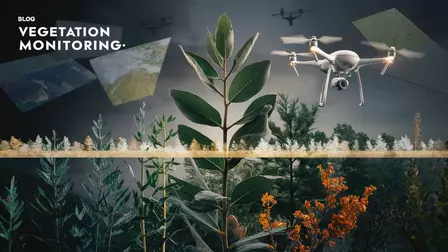Vegetation monitoring, the systematic observation and analysis of plant life, plays a pivotal role in environmental management and conservation. By employing various techniques and technologies, such as remote sensing and drone technology, experts can assess vegetation health, detect changes, and manage ecosystems effectively. This process aids in understanding the impacts of climate change, land degradation, and invasive species on biodiversity. Moreover, it supports ecological restoration and sustainable land management practices, essential for maintaining ecosystem services and promoting precision agriculture.
Accurate vegetation monitoring is crucial for several reasons. It enables the early detection of environmental stressors, informs habitat assessment, and guides biodiversity conservation efforts. Additionally, it provides valuable data for ecological monitoring, helping policymakers and land managers make informed decisions to protect and restore natural habitats.
This guide explores various methods used to assess plant life, including NDVI analysis and field techniques, emphasizing their importance in agriculture, forestry, and grasslands. By showcasing the latest software tools and case studies, readers will understand how these practices contribute to preserving our planet’s ecological balance.
The Importance of Vegetation Monitoring
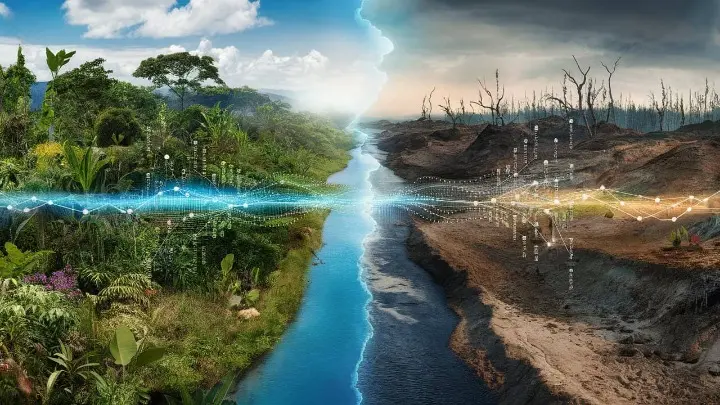
Understanding Ecosystem Health and Dynamics
Vegetation monitoring provides essential insights into ecosystem health and dynamics, serving as a critical tool for ecological monitoring. By analyzing vegetation health assessments, scientists can understand the relationships between plant life and environmental factors, enabling effective ecosystem health assessments. This information aids in biodiversity conservation and habitat assessment, ensuring ecosystems remain balanced and resilient. Through remote sensing for vegetation monitoring, researchers can track changes over time, providing valuable data for land degradation monitoring and ecological restoration efforts.
Assessing the Impact of Climate Change
Vegetation monitoring plays a pivotal role in evaluating the effects of climate change on ecosystems. By using environmental monitoring techniques like NDVI vegetation analysis and drone technology in vegetation monitoring, scientists can detect shifts in vegetation patterns, species distribution, and plant health. These observations are crucial for understanding how climate change impacts ecosystems, guiding mitigation and adaptation strategies. Monitoring vegetation changes also helps in assessing the effectiveness of climate policies and initiatives aimed at reducing greenhouse gas emissions and preserving biodiversity.
Evaluating the Effects of Human Activities
Human activities such as deforestation and land-use changes significantly impact vegetation health and ecosystem stability. Vegetation monitoring allows for the detection of these changes, providing data essential for evaluating their effects. Through field methods for plant monitoring and advanced vegetation monitoring software tools, researchers can assess the extent of deforestation, urban expansion, and agricultural practices. This information supports sustainable land management and ecological restoration efforts, ensuring that human activities do not irreversibly damage natural habitats and biodiversity.
Monitoring Biodiversity and Habitat Quality
Effective biodiversity conservation relies heavily on accurate vegetation monitoring. By tracking plant species diversity, invasive species detection, and habitat quality, scientists can gauge the health of ecosystems. Vegetation change detection methods help identify areas in need of ecological restoration and habitat preservation. Additionally, vegetation monitoring for agriculture ensures that farming practices support biodiversity and ecosystem services, promoting sustainable agriculture and precision agriculture techniques that enhance both productivity and environmental health.
Supporting Sustainable Agriculture and Forestry Practices
Vegetation monitoring is vital for promoting sustainable agriculture and forestry practices. By utilizing vegetation health assessment techniques and vegetation monitoring for agriculture, farmers and foresters can optimize crop and forest management. Monitoring tools provide real-time data on plant health, enabling precision agriculture methods that reduce resource use and increase yields. In forest health monitoring and grassland monitoring techniques, vegetation data supports sustainable land management, ensuring that agricultural and forestry activities contribute to long-term ecological balance and productivity.
Key Techniques and Technologies for Vegetation Monitoring
Effective vegetation monitoring plays a crucial role in maintaining ecosystem health and ensuring sustainable land management. By leveraging various advanced technologies and field methods, scientists can assess vegetation health, detect changes, and make informed decisions for conservation and agriculture. This section delves into the key techniques and technologies used for vegetation monitoring, including remote sensing, field measurements, and drone technology.
Remote Sensing
Remote sensing stands as one of the most powerful tools for vegetation monitoring. By utilizing satellite imagery and various types of sensors, this technique provides comprehensive data on large-scale vegetation patterns and health.
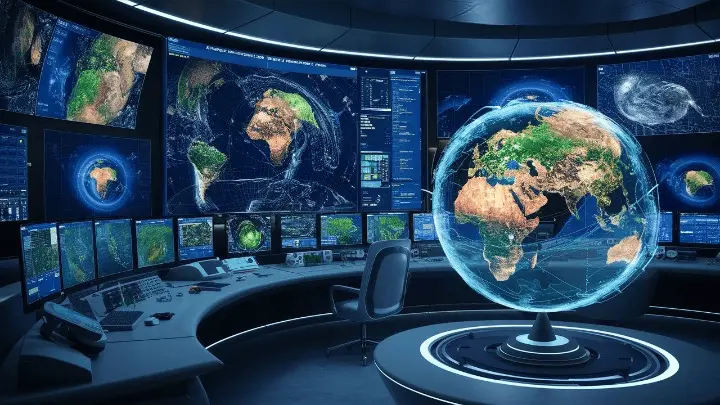
Satellite Imagery
Satellites like Landsat and Sentinel offer invaluable data for vegetation monitoring. Landsat, with its long-term historical data, enables vegetation change detection over decades, while Sentinel provides high-resolution images with frequent revisit times. These satellites capture data that help in understanding broad ecological changes and trends.
Types of Sensors and Data
Remote sensing employs different sensors, including multispectral, hyperspectral, and LiDAR. Multispectral sensors capture data at specific wavelength bands, allowing the analysis of vegetation health through indices like NDVI. Hyperspectral sensors, on the other hand, collect data across continuous spectral bands, offering detailed information on plant composition and stress. LiDAR technology uses laser pulses to measure distances, generating precise 3D models of vegetation structure and topography.
Vegetation Indices
Vegetation indices like the Normalized Difference Vegetation Index (NDVI), Enhanced Vegetation Index (EVI), and Soil-Adjusted Vegetation Index (SAVI) are essential for vegetation health assessment. NDVI, for example, measures the difference between near-infrared and red-light reflectance, indicating plant health and biomass. EVI improves sensitivity in areas with dense vegetation, while SAVI adjusts for soil brightness, providing more accurate vegetation data.
Change Detection Analysis
Remote sensing excels in vegetation change detection, which is crucial for environmental monitoring techniques and land degradation monitoring. By comparing satellite images over time, scientists can identify areas of deforestation, urban expansion, or ecological restoration. This information is vital for biodiversity conservation and sustainable land management practices.
Applications in Forestry, Agriculture, and Land Management
Remote sensing supports a wide range of applications, from forest health monitoring to precision agriculture. In forestry, it helps in detecting invasive species and monitoring forest dynamics. In agriculture, it aids in crop health assessment and optimizing irrigation practices. Additionally, remote sensing assists in habitat assessment and land degradation monitoring, ensuring sustainable ecosystem services.
Field Measurements
While remote sensing provides broad-scale data, field measurements are essential for ground-truthing and obtaining detailed information on vegetation.
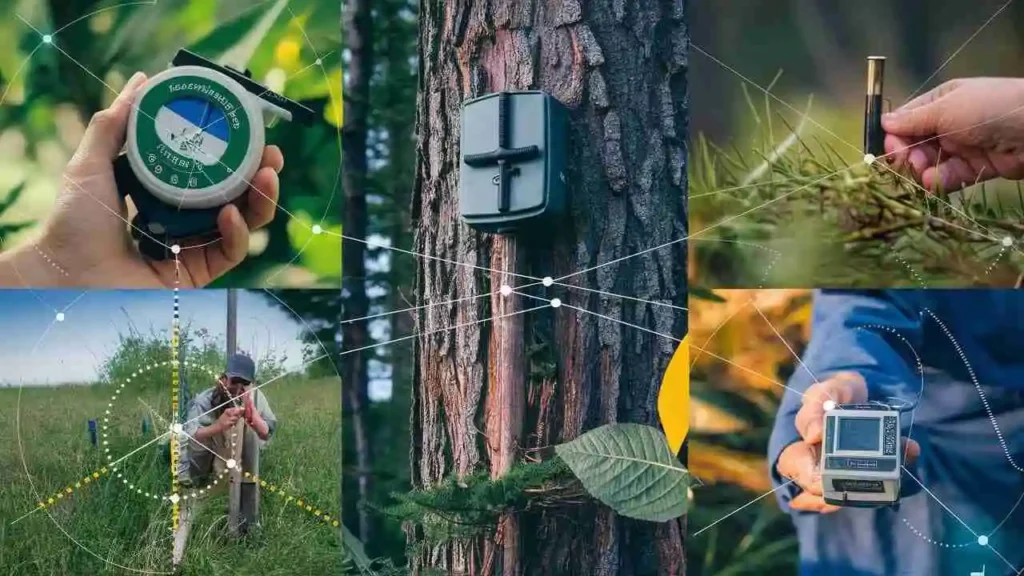
Ground-Truthing Remote Sensing Data
Ground-truthing involves validating remote sensing data with on-the-ground observations. This process ensures the accuracy of satellite-derived information, improving the reliability of vegetation health assessment and ecological monitoring.
Assessing Plant Species Composition, Structure, and Health
Field methods for plant monitoring include assessing species composition, vegetation structure, and overall plant health. By identifying plant species and their abundance, scientists can evaluate biodiversity conservation efforts and habitat health.
Measuring Biomass, Productivity, and Other Biophysical Parameters
Field measurements also involve quantifying biomass, productivity, and other biophysical parameters. These data points are crucial for ecosystem health assessment and understanding the impacts of climate change on vegetation dynamics.
Drone Technology
Drone technology has revolutionized vegetation monitoring by offering high-resolution imagery and flexible data collection methods.
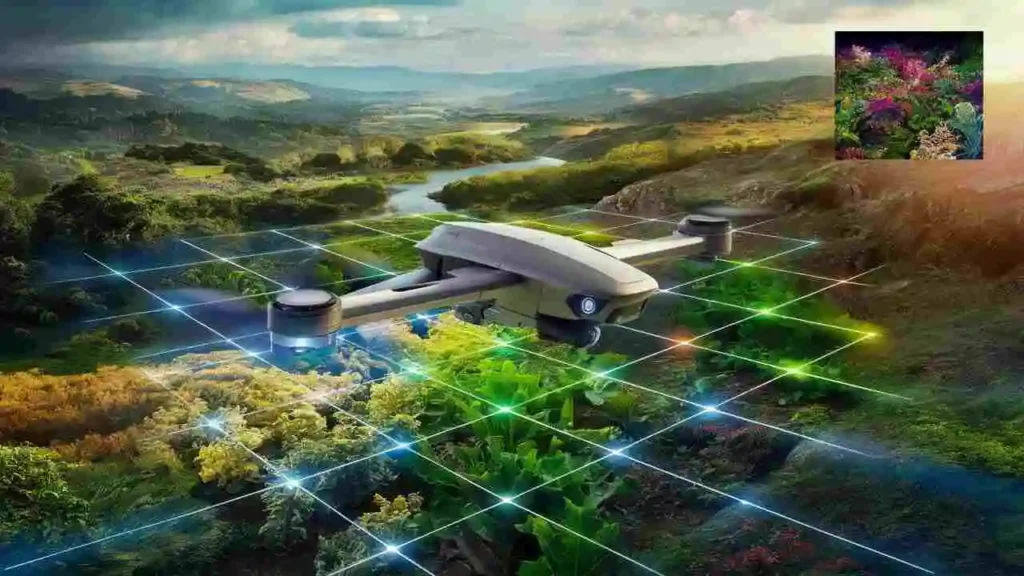
Advantages of Using Drones for Vegetation Monitoring
Drones provide several advantages over traditional methods. They can cover large areas quickly, access hard-to-reach locations, and capture high-resolution images. This makes them ideal for environmental surveys and precision agriculture.
High-Resolution Imagery and Data Collection
Drones equipped with multispectral and hyperspectral cameras can collect detailed data on plant health and stress levels. This high-resolution imagery allows for precise NDVI vegetation analysis, aiding in vegetation change detection and environmental monitoring.
Applications in Precision Agriculture, Forestry, and Environmental Surveys
In precision agriculture, drones help in monitoring crop health, assessing soil conditions, and optimizing resource use. In forestry, they assist in forest health monitoring, invasive species detection, and assessing tree biomass. Additionally, drones play a vital role in ecological restoration projects, providing detailed maps and data for effective intervention.
In conclusion, the integration of remote sensing, field measurements, and drone technology offers a comprehensive approach to vegetation monitoring. These techniques not only enhance our understanding of vegetation health and ecosystem dynamics but also support informed decision-making for conservation and sustainable land management. By leveraging these advanced technologies, we can ensure the continued health and resilience of our planet’s vegetation.
Vegetation Monitoring in Specific Applications
Remote sensing has several applications in vegetation monitoring, including:
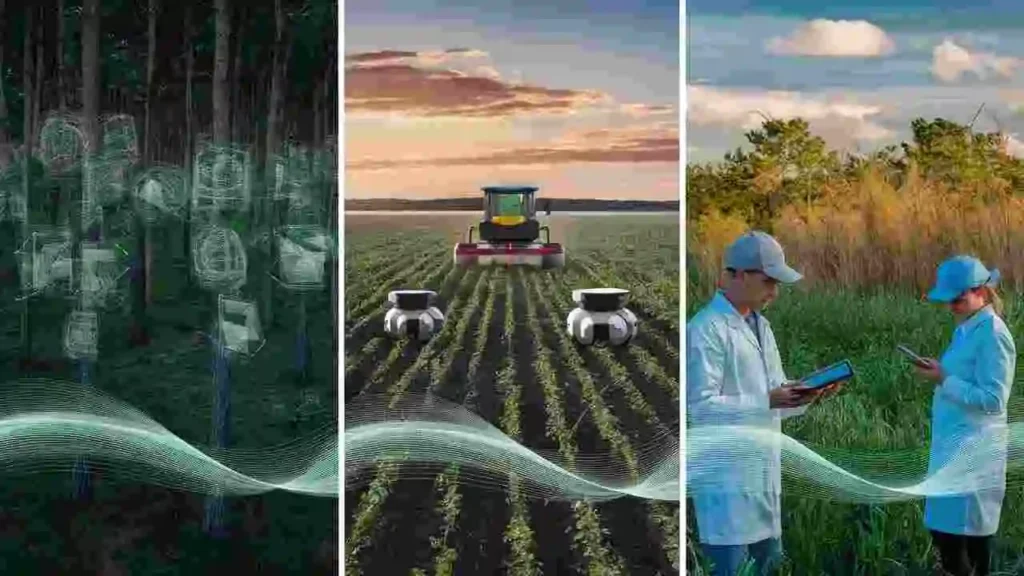
Forestry
Assessing forest health, growth, and carbon sequestration is vital for sustainable forestry practices. Remote sensing, particularly using NDVI analysis, precisely tracks forest dynamics, aiding in the detection of deforestation, illegal logging, and forest fires. This enables timely interventions to mitigate damage. Additionally, monitoring plant health offers valuable insights into forest regeneration and biodiversity, guiding foresters in making informed decisions to enhance carbon sequestration and maintain vital ecosystem services. For example, in the Amazon rainforest, drone-based ecological assessments are used to identify areas affected by illegal activities and guide restoration efforts, ensuring the preservation of critical habitats.
Agriculture
In agriculture, vegetation monitoring is essential for precision agriculture, enhancing crop health assessment and yield optimization. By employing remote sensing and drone technology in vegetation monitoring, farmers can detect water stress, monitor irrigation efficiency, and assess plant health in real-time. Vegetation monitoring for agriculture also identifies pests, diseases, and nutrient deficiencies, enabling timely interventions. Utilizing NDVI vegetation analysis and other environmental monitoring techniques, farmers can optimize resource use and increase productivity.
For instance, field methods for plant monitoring in vineyards help vintners maintain optimal vine health, leading to better grape quality and higher yields. Precision agriculture, supported by advanced vegetation monitoring techniques, ensures sustainable land management and promotes ecosystem health assessment in agricultural landscapes.
Environmental Conservation
Vegetation monitoring is pivotal in environmental conservation for assessing the impact of climate change on ecosystems and monitoring biodiversity and habitat quality. Ecological monitoring, including vegetation change detection, provides valuable data for evaluating the success of restoration projects. Remote sensing for vegetation monitoring, coupled with vegetation monitoring software tools, enables conservationists to track land degradation, habitat loss, and species diversity.
For instance, grassland monitoring techniques help detect invasive species and support ecological restoration efforts, ensuring sustainable land management. Additionally, vegetation monitoring contributes to ecosystem health assessment by identifying areas needing intervention and promoting biodiversity conservation. Case studies in wetland restoration demonstrate how vegetation monitoring aids in maintaining ecosystem services and fostering resilience against climate change impacts, highlighting its importance in sustainable environmental management.
By integrating vegetation monitoring across forestry, agriculture, and environmental conservation, we can enhance ecosystem services, promote sustainable practices, and ensure the health of our natural resources.
Challenges and Future Directions
Effective vegetation monitoring faces several challenges. One key challenge is data integration and analysis. Combining remote sensing, field data, and drone imagery can be complex, requiring sophisticated software tools and expertise. This integration is vital for comprehensive vegetation health assessment and ecological monitoring.
Scaling up monitoring efforts to larger areas presents another challenge. Covering extensive regions with consistent and reliable data demands significant resources and coordination. This is especially crucial for ecological restoration, forest health monitoring, and detecting invasive species.
Cost-effectiveness and accessibility of technologies remain critical issues. Many advanced monitoring tools, such as drone technology and vegetation monitoring software tools, are expensive and may not be accessible to all researchers and land managers. Ensuring these tools are affordable and widely available is essential for sustainable land management and ecosystem health assessment.
Developing standardized protocols and metrics for vegetation change detection and environmental monitoring techniques is necessary for consistency and comparability of data across different studies and regions. Standardization helps in creating reliable vegetation monitoring case studies and facilitates better habitat assessment and biodiversity conservation.
Artificial intelligence (AI) and machine learning hold great promise for the future of vegetation monitoring. These technologies can enhance precision agriculture and improve the accuracy and efficiency of data analysis. Integrating AI in vegetation monitoring can revolutionize ecosystem services and land degradation monitoring, paving the way for innovative solutions in environmental monitoring.
By addressing these challenges, we can advance vegetation monitoring techniques and contribute to more effective ecosystem management and conservation efforts.
Conclusion
Vegetation monitoring remains essential for understanding and managing our ecosystems. With the advent of remote sensing, drone technology, and advanced software tools, we can now monitor vegetation health with greater accuracy and efficiency. These innovations facilitate the early detection of environmental stressors and enable informed decisions for ecological restoration and sustainable land management. Continued research and collaboration are crucial for refining these technologies and addressing challenges in data integration and accessibility. By leveraging these advancements, we can ensure the resilience and sustainability of our natural environments for future generations.

